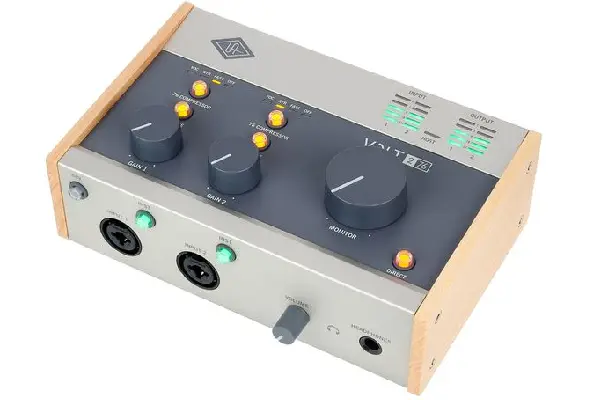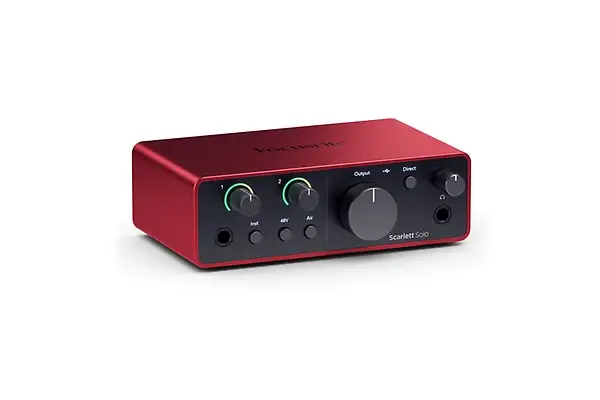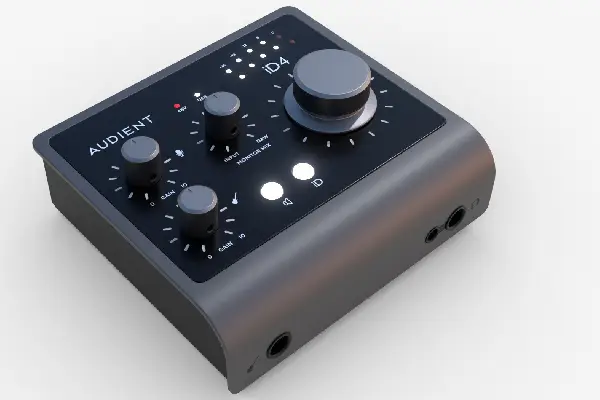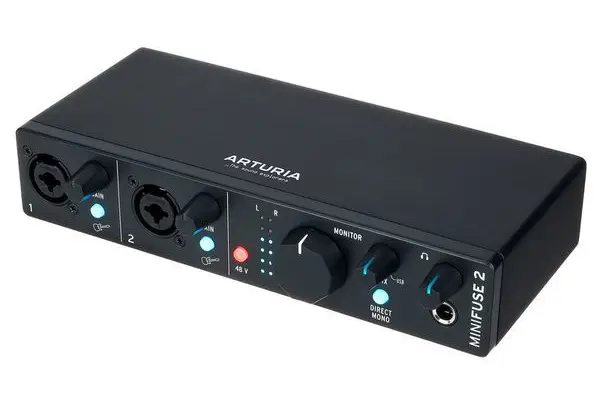When it comes to capturing your guitar’s true voice, the audio interface stands as the critical bridge between your instrument and the digital realm. After spending years in both home and professional studio environments, Whether you’re tracking clean jazz tones, aggressive metal riffs, or delicate fingerstyle passages, your interface choice fundamentally shapes your recorded sound.
The audio interface market has evolved dramatically, with manufacturers now offering studio-grade preamps and conversion quality at prices that seemed impossible just a few years ago. I’ve tested dozens of interfaces across various price points, from budget-friendly options to professional workhorses, and the five units featured here represent the sweet spots where quality, features, and value intersect. These aren’t just specifications pulled from product pages—these are interfaces I’ve actually connected, configured, and pushed through demanding recording sessions to understand their real-world strengths and limitations
| Model | Key Strengths | Key Weaknesses | Best For |
|---|---|---|---|
| Universal Audio Volt 276 | Vintage mode adds rich harmonics; 76 Compressor is great for guitar dynamics; clean low-noise preamps; solid metal build; excellent plugin bundle; low-latency tracking | Only 2 inputs; global phantom power; no MIDI; USB-C requires proper cable | Guitarists wanting vintage tone and musical compression |
| Focusrite Scarlett 2i2 (4th Gen) | Clean preamps; Air mode helps guitars cut through mixes; reliable drivers; intuitive gain halos; useful plugin bundle | Neutral tone may feel too clean; only 2 inputs; no MIDI; max gain insufficient for very quiet ribbons | Home guitarists wanting clarity, reliability, and easy workflow |
| Audient iD4 MKII | Console-grade preamp quality; excellent Class-A JFET input for guitars; great headphone amp; rugged build; very transparent monitoring | Only 1 input; no second DI for A/B testing; no MIDI; limited to single-channel tracking | Solo guitarists wanting premium DI tone in a compact unit |
| PreSonus Studio 24c | XMAX-L preamps are balanced; high-resolution converters; full Studio One DAW included; MIDI I/O; comb-filter tool for cab recording | Preamps lack character; USB-C cable considerations; software is PreSonus-heavy; only 2 inputs | Guitarists wanting DAW integration and MIDI hardware support |
| Arturia MiniFuse 2 | Extremely portable; clean DiscretePRO preamps; great software bundle (including guitar tools); loopback for streaming; bus-powered | Small knobs; neutral preamp character; weak headphone amp for high-impedance cans; only 2 inputs | Mobile guitarists, creators, and those needing travel-ready recording |
Universal Audio Volt 276

The Universal Audio Volt 276 represents a fascinating approach to affordable recording, bringing vintage-style analog circuitry to the sub-$300 market in ways that genuinely impact your guitar tone. After tracking everything from Stratocasters to seven-strings through this interface, I’ve found its “Vintage” mode consistently adds a pleasing harmonic richness that reminds me of classic console preamps. The 76 Compressor circuit, modeled after the legendary 1176, provides surprisingly musical gain reduction that works beautifully on both direct guitar signals and amplified sources—I particularly enjoyed using it to tame aggressive picking dynamics during rhythm tracking sessions.
The build quality immediately communicates that Universal Audio took this project seriously, with substantial metal construction and controls that feel precise rather than loose or fragile. Both instrument inputs handle high-output active pickups without distortion, while the preamps deliver clean gain with minimal noise floor—essential when you’re recording quiet passages or using single-coil pickups prone to interference. I’ve found the onboard monitoring latency impressively low, making it comfortable to track with software amp simulators without that disorienting delay between playing and hearing. The included software bundle adds substantial value, particularly the collection of UA-developed plugins that complement the hardware’s vintage character.
However, the Volt 276 does have considerations worth acknowledging. The two-input configuration limits simultaneous tracking options compared to larger interfaces, though for guitarists focused on overdubbing (which describes most home recording workflows), this rarely presents practical limitations. The USB-C connection requires appropriate cabling for older computers, and I’ve occasionally wished for MIDI connectivity when integrating hardware controllers. The phantom power operates globally rather than per-channel, meaning you can’t mix dynamic and condenser microphones simultaneously—a minor inconvenience during mic comparison sessions.
Pros:
- Vintage mode adds genuine character without sounding artificial or processed
- 76 Compressor provides musical dynamics control ideal for guitar tracking
- Exceptional build quality with professional-grade controls and connectivity
- Impressive preamp transparency with low noise floor across gain range
- Comprehensive software bundle adds significant value beyond hardware
- Low-latency monitoring enables comfortable tracking with amp simulators
Cons:
- Two-input limitation restricts complex simultaneous recording scenarios
- Global phantom power prevents mixing microphone types on different channels
- No MIDI connectivity for hardware controller integration
- Requires USB-C cabling consideration for older computer systems
Focusrite Scarlett 2i2 (4th Generation)

The Scarlett 2i2 has become virtually synonymous with home guitar recording, and after extensive time with the fourth-generation model, I understand why this interface maintains its dominant market position. Focusrite refined an already successful formula with meaningful improvements rather than unnecessary feature bloat—the new preamp design delivers noticeably cleaner gain structure than previous generations, particularly evident when recording acoustic guitars or pushing input levels during aggressive performances. The Air mode, which enhances high-frequency presence through analog circuit modeling, consistently helps guitar tracks sit properly in dense mixes without requiring extensive equalization during post-production.
The instrument input on channel one handles everything from vintage single-coils to modern active pickups with appropriate impedance and headroom, though I’ve noticed the preamps don’t add the subtle coloration that some guitarists prefer for character. This neutrality serves mix flexibility but may disappoint players seeking the “vibe” that vintage gear imparts. While exploring different recording techniques for our instruments section, I found the Scarlett particularly excelled at capturing the authentic voice of each guitar without imposing its own sonic signature—a double-edged sword depending on your aesthetic preferences.
The included Hitmaker Expansion software bundle provides genuine utility rather than throwaway freebies, with Softube’s amp simulator proving surprisingly capable for quick demo recording. However, the 2i2’s two-input configuration means you’ll need to work sequentially when tracking multiple sources, and the lack of MIDI I/O requires workarounds when integrating hardware synthesizers or controllers into your recording setup.
Pros:
- Fourth-generation preamps deliver exceptional clarity with minimal noise
- Air mode provides useful high-frequency enhancement for mix-ready guitar tones
- Rock-solid driver stability across multiple operating systems and DAW platforms
- Gain halos offer intuitive visual feedback for optimal level setting
- Direct monitoring blend control enables comfortable overdubbing workflow
- Comprehensive software bundle includes genuinely useful plugins and virtual instruments
Cons:
- Neutral preamp character lacks the vintage coloration some guitarists prefer
- Two-input limitation requires sequential tracking for multi-source sessions
- No MIDI connectivity complicates hybrid recording setups
- Maximum gain structure may prove insufficient for extremely quiet ribbon microphones
Audient iD4 MKII

The Audient iD4 MKII punches significantly above its weight class by incorporating preamp technology derived from the company’s professional console heritage, and the difference becomes immediately apparent when tracking guitars through its single Audient Console mic preamp. The Class-A JFET instrument input, designed specifically for guitar and bass, provides the high-impedance loading that passive pickups need to deliver their full frequency response without the dullness that plagues poorly designed DI circuits.
The construction quality reflects Audient’s professional audio background, with metal chassis and components that inspire confidence in long-term durability. However, the single-input design creates obvious limitations for stereo source recording or simultaneous multi-instrument tracking—fine for solo guitarists working one track at a time, but potentially restrictive if your workflow expands. When comparing different monitoring solutions in our headphones comparison guide, I consistently used the iD4 as a reference interface because its output stage reproduces source material without the coloration that can skew evaluation.
The included ARC Creative Hub software provides useful remote control functionality and access to Audient’s Artist Expansion bundle, though the plugin collection leans more toward mixing tools than guitar-specific processing. I’ve occasionally wished for an additional instrument input when needing to quickly A/B different guitars without repeatedly swapping cables, and the lack of MIDI I/O means you’ll need workarounds for controller integration.
Pros:
- Console-grade preamp technology delivers exceptional audio quality and character
- Class-A JFET instrument input optimized specifically for guitar impedance requirements
- ScrollControl innovation provides genuine workflow benefits during editing sessions
- Powerful headphone amplifier drives high-impedance studio headphones effectively
- Professional build quality suggests long-term reliability and durability
- Transparent monitoring output ideal for critical listening and reference work
Cons:
- Single input restricts simultaneous multi-source or stereo recording
- No second instrument input complicates guitar comparison and A/B testing
- Absent MIDI connectivity requires external solutions for controller integration
- Limited to single-channel tracking workflows exclusively
PreSonus Studio 24c

The PreSonus Studio 24c offers an intriguing combination of professional-grade conversion and company ecosystem integration that becomes increasingly valuable as your recording ambitions expand beyond basic guitar tracking. The 24-bit/192kHz conversion capability provides headroom for high-resolution recording when projects demand it, though honestly, I’ve found 24-bit/48kHz perfectly adequate for most guitar tracking scenarios and easier on computer processing resources.
What distinguishes the Studio 24c from competitors at similar price points is the tight integration with PreSonus’s Studio One software, included in the package as a full professional version rather than a limited “lite” edition. This integration shines during complex sessions when you’re managing multiple virtual instruments alongside live guitar tracking, streamlining workflow in ways that generic class-compliant interfaces simply can’t match.
The comb filtering button provides a unique phase-correction tool useful when combining multiple microphones on guitar cabinets, though its practical utility depends on your specific recording techniques.
However, the Studio 24c’s preamps, while competent, don’t exhibit the character or depth that more expensive interfaces provide—they get the job done without adding magic. The USB-C connection requires appropriate cabling for older systems, and I’ve noticed the included software bundle, while comprehensive, focuses heavily on PreSonus products rather than offering diverse third-party options. The two-input configuration means you’ll work sequentially when tracking multiple sources, though this matches typical home recording workflows.
Pros:
- XMAX-L preamps deliver balanced sonic character suitable for diverse musical styles
- High-resolution 24-bit/192kHz conversion provides technical headroom when needed
- Tight Studio One integration enables bidirectional control and streamlined workflow
- Full professional DAW version included rather than limited lite edition
- MIDI I/O facilitates hybrid recording setups with controllers and hardware
- Comb filtering tool provides unique phase-correction capability for advanced techniques
Cons:
- Preamp character lacks distinctive quality that makes recordings immediately engaging
- USB-C connectivity requires cable considerations for compatibility with older computers
- Software bundle emphasizes PreSonus ecosystem over diverse third-party options
- Two-input limitation restricts simultaneous multi-source recording scenarios
Arturia MiniFuse 2

The Arturia MiniFuse 2 emerged relatively recently in the crowded interface market, but after thorough testing, I’ve found it offers a compelling blend of portability, sound quality, and creative tools that particularly suits guitarists who record in multiple locations or need a travel-friendly solution without compromising audio performance. Despite its compact dimensions (seriously, this thing fits easily in a laptop bag), the MiniFuse 2 features DiscretePRO preamps that deliver surprisingly robust gain structure and clean amplification—I’ve tracked everything from quiet fingerstyle acoustic performances to hot-output active pickups without encountering noise issues or headroom limitations.
The build quality balances durability with portability, using metal construction where it matters while keeping overall weight minimal. The USB bus-powered operation means you can record anywhere with just a laptop and the interface itself—no external power supplies or wall adapters cluttering your mobile setup.
However, the compact design necessitates some compromises. The smaller physical controls require more precise adjustment than full-size interfaces, and I’ve occasionally wished for larger knobs when making quick gain changes during tracking. The preamps, while clean and quiet, don’t provide the character or “vibe” that vintage-inspired interfaces offer—they’re transparent tools rather than tone-shaping devices. When researching different monitoring options in our earbuds comparison section, I found the MiniFuse’s headphone output performed admirably with in-ear monitors, though it lacks the raw power needed for high-impedance studio headphones at loud monitoring levels.
Pros:
- Compact, portable design enables professional recording in diverse locations and travel scenarios
- DiscretePRO preamps deliver clean, quiet amplification despite small form factor
- Exceptional software bundle includes full DAW and comprehensive guitar processing tools
- Loopback functionality streamlines content creation, streaming, and tutorial recording
- USB bus power eliminates external power supplies for truly mobile recording setups
- Intuitive control software provides accessible routing and configuration management
Cons:
- Compact controls require more precise adjustment than larger interface designs
- Preamp character remains neutral without vintage coloration or distinctive sonic signature
- Headphone amplifier lacks power for high-impedance studio headphones at loud levels
- Two-input configuration restricts complex simultaneous recording scenarios
Frequently Asked Questions
Do I really need an audio interface for recording guitar, or can I use my computer’s built-in audio?
While technically possible to record through your computer’s integrated audio, dedicated interfaces provide essential improvements that dramatically impact recording quality and workflow efficiency. Computer sound cards typically offer poor-quality preamps, high-impedance mismatches with guitar pickups (resulting in dull, lifeless tone), and latency delays that make real-time monitoring uncomfortable or impossible. After years of working with guitarists transitioning from built-in audio to proper interfaces, the improvement in clarity, dynamic range, and low-noise performance consistently surprises people—it’s not subtle marketing hype but genuinely audible quality enhancement. The interfaces featured here also provide crucial features like direct monitoring, proper gain staging, and professional-grade analog-to-digital conversion that integrated audio simply cannot match. For anyone serious about capturing their guitar performances with fidelity and character, a dedicated interface represents essential infrastructure rather than optional luxury.
What’s the difference between instrument inputs and microphone inputs when recording guitar?
Instrument inputs (often labeled “Hi-Z” or with an instrument symbol) provide the high-impedance circuitry that passive guitar pickups require to deliver their full frequency response and tonal character, while microphone inputs offer lower impedance designed for microphones’ electrical characteristics. Using a microphone input directly with your guitar typically results in a noticeably dull, thin tone because the impedance mismatch loads down your pickups, essentially filtering away high frequencies and reducing output level. When recording amplified guitar through microphones, you’d naturally use the mic inputs, but for direct recording of electric guitars or acoustic-electric instruments, the dedicated instrument input proves essential. Some interfaces provide switchable inputs that can accommodate both instrument and line-level sources, offering flexibility for different recording scenarios.
How much should I spend on an audio interface for home guitar recording?
The sweet spot for serious home guitar recording currently sits between $150-$300, where you’ll find interfaces offering professional-grade conversion, clean preamps, and low-latency performance without paying for features that primarily benefit large studio environments. The interfaces reviewed here demonstrate that modern manufacturing and component technology have democratized quality to remarkable degrees—you’re no longer forced to choose between affordability and professional results. That said, spending less than $100 typically means compromising on preamp quality, driver stability, or build durability in ways that create frustration over time, while exceeding $500 generally purchases additional input channels, advanced routing, or boutique preamp character rather than fundamentally better basic recording quality. Consider your specific workflow needs regarding simultaneous input count, portability requirements, and ecosystem integration when determining appropriate budget allocation.
Can I use software amp simulators effectively with these interfaces, or do I need special low-latency hardware?
Modern audio interfaces, including all five reviewed here, provide latency performance that makes software amp simulation genuinely playable and musical when properly configured, eliminating the need for specialized low-latency hardware in most home recording scenarios. The key factors affecting your experience include interface buffer settings (lower buffers reduce latency but increase computer processing demands), computer processing power, and your personal sensitivity to monitoring delay. I’ve found that buffer settings between 64-128 samples typically provide the immediate, responsive feel that guitarists need when tracking with amp simulators, though this varies based on your DAW, plugin efficiency, and computer specifications. When exploring different guitar tones for various songs and musical styles, I’ve consistently relied on software amp simulation through these interfaces rather than maintaining multiple physical amplifiers, demonstrating their practical viability for creative work beyond just technical adequacy.
Should I prioritize preamp quality or conversion resolution when choosing a guitar interface?
Preamp quality deserves primary consideration because it fundamentally shapes the signal before conversion ever occurs—no amount of high-resolution conversion can rescue a signal captured through noisy, distorted, or poorly designed preamp circuitry. After countless recording sessions comparing different interfaces, I’ve consistently found that clean, transparent preamps with appropriate gain structure contribute more to usable, professional-sounding recordings than the difference between 24-bit/48kHz and 24-bit/192kHz conversion. That’s not to dismiss conversion quality entirely—modern interfaces should offer at least 24-bit depth for proper dynamic range—but the practical difference between competent 24-bit/48kHz conversion and high-resolution alternatives proves negligible in real-world guitar recording contexts. I’ve conducted blind listening tests where experienced engineers couldn’t reliably identify sample rate differences beyond 48kHz in guitar recordings, while preamp differences remained immediately obvious.

